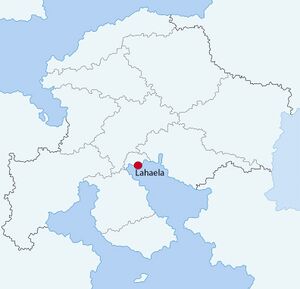Lo Lanno
This article is incomplete because it is pending further input from participants, or it is a work-in-progress by one author. Please comment on this article's talk page to share your input, comments and questions. Note: To contribute to this article, you may need to seek help from the author(s) of this page. |
Lahaela
라해라 | |
|---|---|
Capital City | |
Image of downtown Lahaela and Lahaela Palace | |
| Nickname: Hael/Haela | |
Lahaela, marked on a map of The Cape Bay | |
| Country | The Cape Bay |
| Territory | Lahaela Metro |
| First Established | ~3,000BCE |
| Founded by | Unknown |
| Capital | Bajing |
| Government | |
| • Body | Council of Lahaela |
| • Mayor | Tara Mala-Seng-Hweon (Green - Urban) |
| Area | |
| • Capital City | 6,123 km2 (2,364 sq mi) |
| • Urban | 2,342 km2 (904 sq mi) |
| • Rural | 3,781 km2 (1,460 sq mi) |
| • Metro | 6,123 km2 (2,364 sq mi) |
| Elevation | 9 m (30 ft) |
| Population (2022) | |
| • Capital City | 29,837,815 |
| • Density | 4,900/km2 (13,000/sq mi) |
| Demonym | Lahaelan |
| Time zone | -2 |
| City Code | 1L-1H-1L |
| Website | www |
Lahaela is the biggest and most important city in The Cape Bay. It is the capital of the nation as well as where tourists and immigrants flock to to enjoy the hot summers, beautiful cityscape and stunning beaches and nature. The city is also one of the skyscraper capitals of the world with over 170 completed buildings, however it is still second to Port Adela just in The Cape Bay, which has over 300. Lahaela is the seat of government as well as home to the main palace of the Cape Royal Family, Lahaela palace.
History
Ancient History
Lahaela was first founded around the year 3,000BCE by local tribes and due to its strategic position helped the tribe expand into the Salkik Empire which conquered much of the southern coast of the modern Cape Bay. The city quickly grew and the first palace was built only a hundred or so years after the foundation, it is even thought that Lahaela meant 'palace' or 'seat of government' in ancient Aljian. The city had strong control over the empire and managed to sustain itself on agriculture selling things like fruits, spices and and becoming a trading hub for the Empire. Eventually when it was time to give the empire subdivisions, Lahaela was given its own jurisdiction to expand with the city, this also let people in the city be governed by different laws, giving them more rights than the outlying peasants, which began mass immigration from the country sides to the city. When the Salkik empire collapsed in 982AD the Chushga Empire took hold of the city and expanded it down to the island of Al Siyara and up to Rie Lake, keeping Lahaela the capital of the growing empire.
Colonial Times
In the year 1550 the Riamese Empire colonised the southern island of Al Siyara which they eventually used as a strategy point to invade the Chushga Empire in 1599 and took control of all of it by 1652AD. The capital for the new Riamese colony was set as Lahaela as it was the largest city at the time. It continued to be the most important city in keeping the colony stable, so extra attention was given to it throughout the colonisation period. Around 1794 the Royal Family of 'The Royal Cape' (as it was called at the time), were thrown out of the city and fled to the Northern Saho Islands which were not colonised until independence. Due to this removal, anti-riamese sentiments grew which resulted in the native people burning down Riamese neighbourhoods and buildings. In retaliation the Riamese burnt down multiple historic neighbourhoods and landmarks which sparked an independence movement in the south colony. They tried to secede from the colony and expel the Riamese people from their cities, especially Lahaela, however success was only partial. As Lahaela was not in a good strategic defensive position, being surrounded by the empire on all sides except for one, the capital was changed to Sokiyara, a smaller city on the west coast of Rie Lake. This left Lahaela undefended and allowed the city to be split into half, the west side being primarily Riamese occupied and the east being occupied by The Free Territory of Deljuna. In this time the city developed two different sides. On both, settlements were torn down and replaced with architecture better suited to either culture and both sides engaged with a mass expansion of the city, creating even bigger divides over the time that the city was split. The Free Territory of Deljuna only lasted 71 years, and in 1865 it collapsed due to mass food shortages after an extreme heat wave and subsequent fever passed over the nation.

